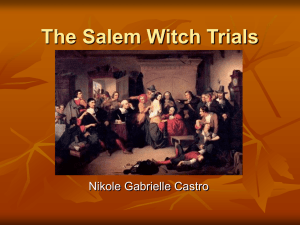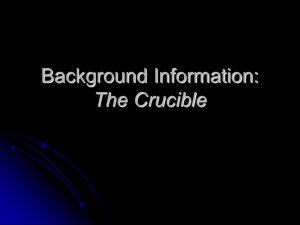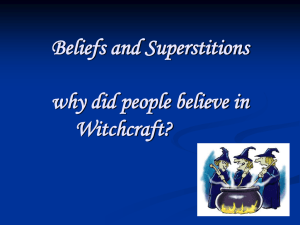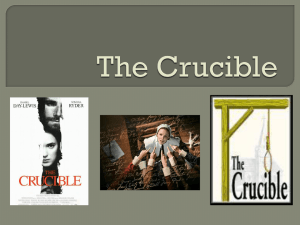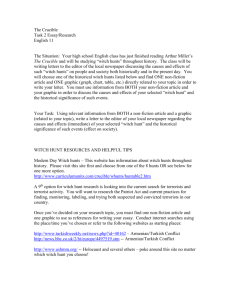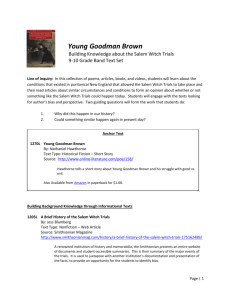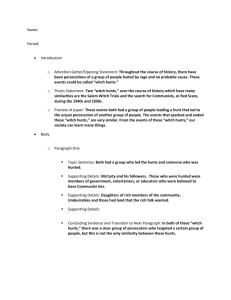{Contributor: For an entry of this length, we won`t need quite so many
advertisement
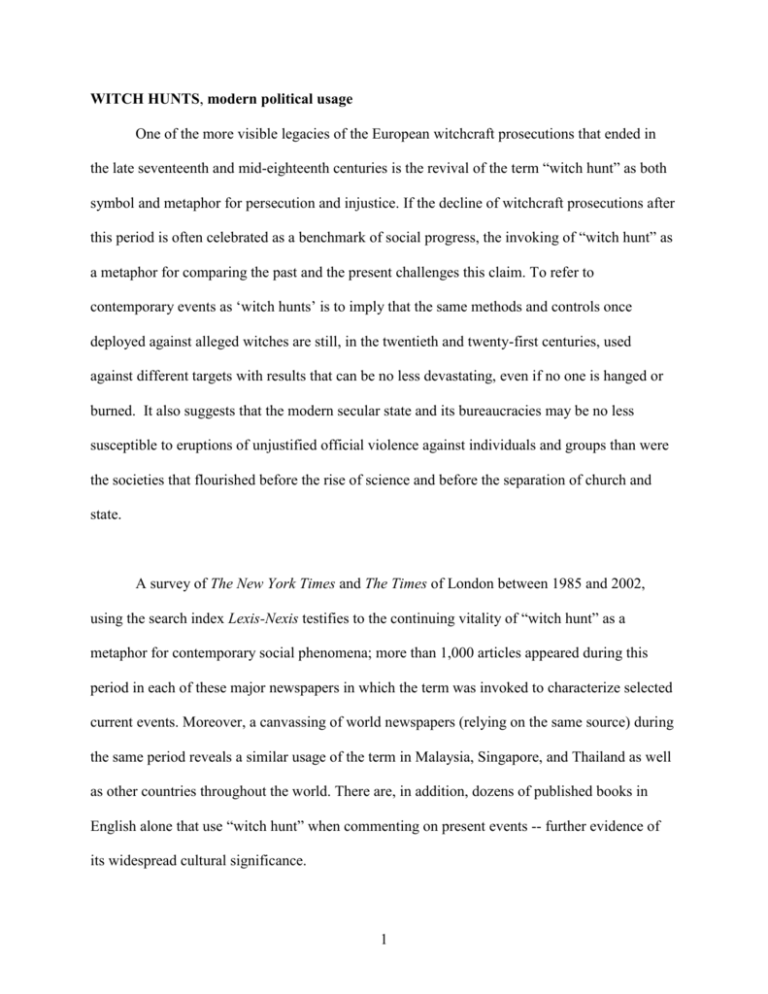
WITCH HUNTS, modern political usage One of the more visible legacies of the European witchcraft prosecutions that ended in the late seventeenth and mid-eighteenth centuries is the revival of the term “witch hunt” as both symbol and metaphor for persecution and injustice. If the decline of witchcraft prosecutions after this period is often celebrated as a benchmark of social progress, the invoking of “witch hunt” as a metaphor for comparing the past and the present challenges this claim. To refer to contemporary events as ‘witch hunts’ is to imply that the same methods and controls once deployed against alleged witches are still, in the twentieth and twenty-first centuries, used against different targets with results that can be no less devastating, even if no one is hanged or burned. It also suggests that the modern secular state and its bureaucracies may be no less susceptible to eruptions of unjustified official violence against individuals and groups than were the societies that flourished before the rise of science and before the separation of church and state. A survey of The New York Times and The Times of London between 1985 and 2002, using the search index Lexis-Nexis testifies to the continuing vitality of “witch hunt” as a metaphor for contemporary social phenomena; more than 1,000 articles appeared during this period in each of these major newspapers in which the term was invoked to characterize selected current events. Moreover, a canvassing of world newspapers (relying on the same source) during the same period reveals a similar usage of the term in Malaysia, Singapore, and Thailand as well as other countries throughout the world. There are, in addition, dozens of published books in English alone that use “witch hunt” when commenting on present events -- further evidence of its widespread cultural significance. 1 The events to which the category is applied are as varied as the societies and the times in which they occur. False accusations of child abuse in England, the prosecution of a British nanny in Massachusetts on charges of murdering an infant in her care, attempts to remove gay clergy from Australian pulpits, the court-martial of US military officers engaging in extramarital relations, and proposed anti-terrorism legislation in Australia -- these are just a few of the recent events that journalists and other commentators have compared to witch hunts. Yet, through this welter of phenomena, several common themes emerge. First, and most transparently, invoking the category is almost invariably pejorative; to refer to an event as a “witch hunt” is by definition to invite moral condemnation by implying that it is unfair or malicious or both. Second, the actions described as ‘witch hunts’ are almost always those of public officials acting under the authority of the state or some other powerful organization, often in the form of a prosecution but usually involving some form of aggressive interference in the lives of private citizens. Third, the targets of actions defined as ‘witch hunts’ tend to be persons who are marginal or nonconforming, religiously or politically or behaviorally. Finally, the “witch hunt” is perceived as an intervention that is either grossly disproportional to the wrongdoings that preceded it, or a complete miscarriage of justice that results in the punishment of the innocent. These features reveal both what witch hunts mean to contemporaries and what characteristics contemporaries have come to associate with witch hunts. Modern Witch Hunts? For no events in recent history has the metaphor of the “witch hunt” been elaborated quite as vigorously as for the congressional hearings into the presence of Communists in the late 1940's and early 1950's in the United States, and for prosecutions for ritual child abuse that 2 occurred in the late 1980's through to the late 1990's mostly in the United States but also in Canada and England. Not surprisingly, given their Anglo-American bias, the exemplar for this search for correspondence has been the Salem witchcraft prosecutions of 1692. The parallels that have most impressed contemporaries are the power of the human imagination to give human form to its deepest fears, and the capacity present even in modern states committed to the rule of law and to empirical science to create conspiracies of their own making. In particular, commentators have suggested broad similarities in the process by which suspicions were generated and then elaborated into full-fledged accusations that in turn generated more accusations and convictions. Just as the Salem trials were propelled by a form of evidence that placed defendants at an impossible disadvantage, so also were both the allegations that triggered the House Un-American Activities Committee (HCUA) in the mid-twentieth-century United States, and the allegations of ritual abuse some 40 years later, which could not be refuted no matter how improbable or unfounded. “Spectral evidence” in 1692 was based on the belief that victims of witchcraft had a special gift to see the specter or otherworldly likeness of the witch who was tormenting them. No matter how accused persons comported themselves and no matter how they behaved, the testimony of the victim proved his guilt in the eyes of the juries and magistrates who returned verdicts of guilty and imposed penalties of death according to the law. Only through confession and by implicating others could persons suspected of witchcraft delay or mitigate the punishment of death by hanging. Persons who criticized the proceedings were at risk of being accused. The result was a process in which the web of suspicion was rapidly and continuously amplified until its sudden cessation a year later. 3 The congressional investigations into “Un-American” Activities likewise loosened the criteria for active subversion of the American government by placing under suspicion not only persons who had been members of the Communist Party at any time, but also members of any organization perceived as sympathetic to the Communist Party; any authorship or participation in films that endorsed values that were perceived as compatible with those of the Communist Party; and anyone who associated with someone in the above categories. To come under suspicion was to risk severe repercussions, especially loss of employment and loss of reputation. To rehabilitate one’s reputation and to protect one’s livelihood, it was necessary to confess one’s misdeeds and to implicate others. Refusal to testify or refusal to give the names of one’s confederates were taken as equivalent to a statement of guilt. To criticize the proceedings was to risk being placed under investigation. Just as in the Salem trials, the search for Communist infiltrators into the core of American institutions generated more and more suspects until it too was dismantled. The mass prosecutions that resulted in the conviction and subsequent acquittal or overturning on appeal of hundreds of persons charged with the ritual abuse of young children have also been viewed through the prism of the Salem trials, albeit from a different vantage point. Here what has most struck contemporaries has been the validation of children’s testimony no matter how improbable and completely unsupported by physical evidence, while ignoring the unacknowledged responsibility of therapists, police, social workers, and others in actively shaping the children’s testimony. Through aggressive interrogation and fear of worse punishment, many false confessions were generated that in turn generated more accusations and convictions. Only after the mounting of costly appeals backed by experts who challenged the findings of the courts have appellate courts thrown out most of the incriminating evidence as lacking in credibility and as irrevocably tainted by the leading questions of adults in authority. 4 Journalists and academics who have written about these trials have focussed on what they identify as parallels between the use of evidence in these cases- child witnesses coached by adults with preconceived ideas - and the use of child witnesses to give spectral evidence during the Salem trials and its validation by magistrates, clergy, villagers, and others. Just as in the Salem trials, when official pressure was removed, confessors recanted their confessions. That each of these official initiatives was able to generate evidence to confirm the worst fears of their respective communities can be taken as a further point of similarity. Through the testimony of confessors, members of the Massachusetts Bay colony learned of a conspiracy of witches consisting of otherwise respectable members of the church that sought to destroy Salem village and to replace it with a kingdom presided over by the Devil. The hearings into UnAmerican activities produced revelations of a vast Communist conspiracy that had penetrated into the very core of American military and political institutions. The mass prosecutions of the 1980s and 1990s resulted in confessions that spoke of secret associations of otherwise lawabiding adults who engaged in extreme acts of sexual violation of young children as part of a Satanic or cult-like ritual. For some commentators, the use of “witch hunt” as a metaphor is misplaced and anachronistic. For others, it is a sobering reminder of the fragile boundaries separating the present from the barbarities of a past that was certainly not the “good old days.” But, if as Norman Cohn has written, the witch hunt “illustrates vividly the power of the human imagination to build up a stereotype and its reluctance to question the stereotype once it is generally accepted” (Cohn, 5 1975, 225), then it is no wonder that it continues to be useful as a tool of analysis and as a reference point for contemporary phenomena. --Richard Weisman See also Miller, Arthur; Salem; spectral evidence; witch craze; witch hunts References and Further Reading: Belfrage, Cedric. 1973. The American Inquisition 1945-1960. New York: The Bobbs- Merrill Company. Cohn, Norman. 1975. Europe’s Inner Demons: An Enquiry Inspired by the Great Witch hunt. New York: Basic Books. McWilliams, Carey. 1950. Witch Hunt-The Revival of Heresy. Boston: Little, Brown, and Company. Miller, Arthur. 2000. “The Crucible in History.” Pp.274-295 in Echoes Down the Corridor: Collected Essays, 1944-2000. Edited by Steven R. Centola. New York: Viking Press. Nathan, Debbie and Michael R. Snedeker. 1995. Satan’s Silence: ritual abuse and the making of a modern American witch hunt. New York: Basic Books. Rosenthal, Bernard. 1993. Salem Story: Reading the Witch Trials of 1692. Cambridge: Cambridge University Press. Showalter, Elaine. 1997. Hystories: Hysterical Epidemics and Modern Culture. New York: Columbia University Press. Weisman, Richard. 1984. Witchcraft, Magic, and Religion in 17th Century Massachusetts. Amherst: University of Massachusetts. 6


